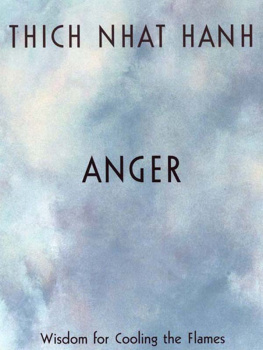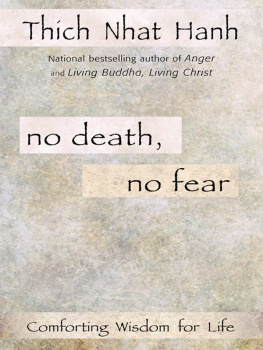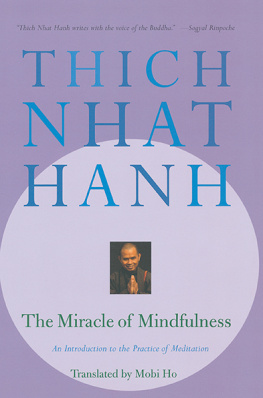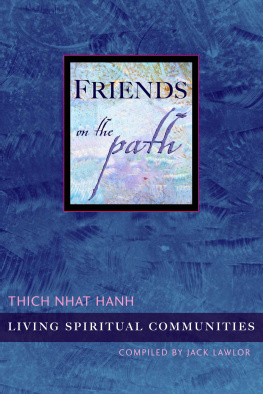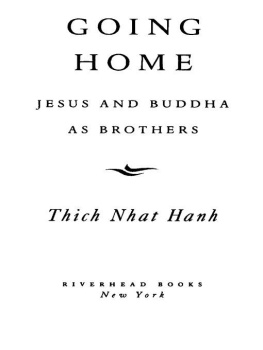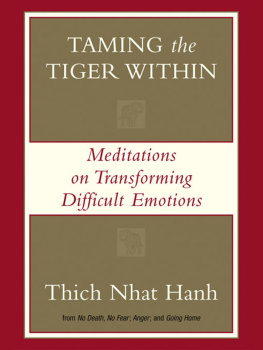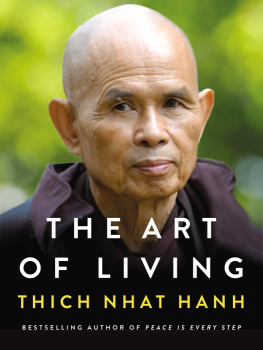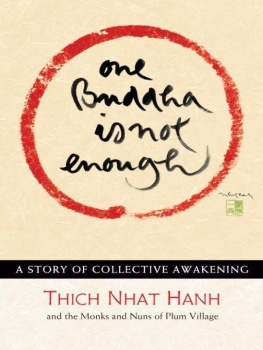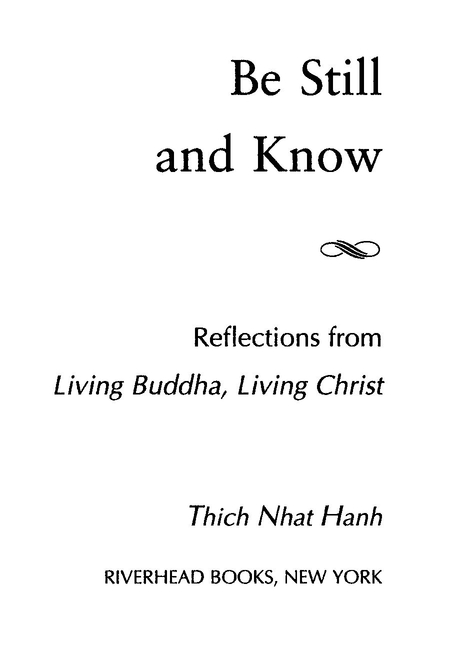Table of Contents
Reflections from
Living Buddha, Living Christ
Other Books byThichNhat Hanh
ANGER
LIVING BUDDHA, LIVING CHRIST
FRAGRANT PALM LEAVES
BEING PEACE
THE BLOOMING OF A LOTUS
BREATHE! YOU ARE ALIVE
CALL ME BY MY TRUE NAMES: THE COLLECTED POEMS OF THICH NHAT HANH
CULTIVATING THE MIND OF LOVE
FOR A FUTURE TO BE POSSIBLE
THE HEART OF UNDERSTANDING
THE LONG ROAD TURNS TO JOY
LOVE IN ACTION
THE MIRACLE OF MINDFULNESS
OLD PATH WHITE CLOUDS
PEACE IS EVERY STEP
PRESENT MOMENT
WONDERFUL MOMENT
THE SUN MY HEART
TEACHINGS ON LOVE
TOUCHING PEACE
TRANSFORMATION AND HEALING
Be still and know that I am God.
Psalm 46
Be still means to become peaceful and concentrated. The Buddhist term is samatha (stopping, calming). Know means to acquire wisdom or understanding. The Buddhist term is vipasyana (insight, or looking deeply). When we are still, looking deeply, and touching the source of our true wisdom, we touch the living Buddha and the living Christ in ourselves and in each person we meet.
DIALOGUE
On the altar in my hermitage in France are images of Buddha and Jesus, and every time I light incense, I touch both of them as my spiritual ancestors.
I am able to do this because I have met many real Christians, men and women whose lives and words embody the deepest aspects of the Christian tradition.
Most of the boundaries between traditions are artificial. Truth has no boundaries. The differences are mostly in emphasis.
Do not think the knowledge you presently possess is changeless, absolute truth. Avoid being narrow-minded and bound to present views. Learn and practice nonattachment from views in order to be open to receive others viewpoints.
When we look into the heart of a flower, we see clouds, sunshine, minerals, time, the earth, and everything else in the cosmos in it. Without clouds, there could be no rain, and there would be no flower.
No single tradition monopolizes the truth. We must glean the best values of all traditions and work together to remove the tensions between them. If we do, peace will have a chance.
For dialogue to be fruitful, we need to live deeply our own tradition and, at the same time, look and listen deeply to others. We can appreciate the beauty and value of our own and the others tradition.
To stand straight and grow strong, we need roots. After one retreat, a young man told me, Thy, I feel more Jewish than ever. I will tell my rabbi that a Buddhist monk inspired me to go back to him.
Dialogue must begin, first of all, within oneself. If we cannot make peace within, how can we hope to bring about peace in the world?
True love contains respect. When you practice respect, your love and happiness will continue for a long time.
True love is possible only with understanding. When there is understanding, compassion is born.
MINDFULNESS AND THE HOLY SPIRIT
The Buddha was asked, Sir, what do you and your monks practice? He replied, We sit, we walk, and we eat. The questioner continued, But sir, everyone sits, walks, and eats, and the Buddha told him, When we sit, we know we are sitting. When we walk, we know we are walking. When we eat, we know we are eating. In Buddhism, our effort is to practice mindfulness in each momentto know what is going on within and all around.
Mindfulness is the substance of a Buddha. When you enter deeply into the present moment, you, too, become a living Buddha. You see the nature of reality, and this insight liberates you from suffering and confusion.
To me mindfulness is very much like the Holy Spirit. When you are mindful, you see more deeply, and you can heal the wounds in your own mind through love and understanding. It is not just touching a cloth that brings about a miracle. When you touch deep understanding and love, you are healed.
The Holy Spirit descended on Jesus like a dove, penetrated Him deeply, and He became the manifestation of the Holy Spirit. With the Holy Spirit in Him, Jesus power as a healer transformed many people. We also have the seed of the Holy Spirit in usthe capacity of healing, transforming, and loving. When we touch that seed, we touch God the Father and God the Son.
A twelve-year-old boy was asked by his father, What would you like for your birthday? The boy replied, Daddy, I want you!
His father worked all the time and was rarely at home. His son was a bell of mindfulness, reminding him that the most precious gift we can offer our loved ones is our true presence.
When our mindfulness embraces those we love, they bloom like flowers.
Mindful speech brings real happiness. Unmindful speech can kill. It doesnt cost anything to use loving speech. Choose your words carefully and you will make many people happy.
We all need something good, beautiful, and true to believe in. Taking refuge in mindfulness, the awareness of what is going on in the present moment, is safe and not at all abstract.
When Buddhists greet one another, we hold our palms together like a lotus flower, breathe in and out mindfully, bow, and say silently, A lotus for you, a Buddha-to-be. This greeting produces two Buddhas at the same time.
The miracle is not to walk on water. The miracle is to walk on the green earth, dwelling deeply in the present moment and feeling truly alive.
LIVING BUDDHA, LIVING CHRIST
In Crossing the Threshold of Hope, Pope John Paul II says, If [Christ] were only a wise man like Socrates, if He were a prophetlike Muhammed, if He were enlightenedlike Buddha, without any doubt He would not be what He is. He is the one mediator between God and humanity. Behind this statement is the notion that Christianity provides the only way of salvation and all other religious traditions are of no use. This attitude excludes dialogue and fosters religious intolerance and discrimination. It does not help.
When we read, The heavens opened and the Holy Spirit descended upon Him like a dove, we can see that Jesus Christ was already enlightened. He was in touch with the reality of life, the source of mindfulness, wisdom, and understanding within Him, and this made Him different from other human beings. When He was born into a carpenters family, He was the Son of Man. When He opened His heart, the door of Heaven was opened to Him. The Holy Spirit landed Him like a dove, and then He was the Son of God. He became very holy and very great.
Jesus is the Son of God and the Son of Man. We are all, at the same time, the sons and daughters of God and the children of our parents. This means we are of the same reality as Jesus. This will sound heretical to many Christians, but I believe that theologians who say we are not have to reconsider.
(Jesus lived exactly as he taught, so studying His life is crucial to understanding His teaching. For me, the life of Jesus is His most basic teaching, even more important than faith in the resurrection or faith in eternity.


